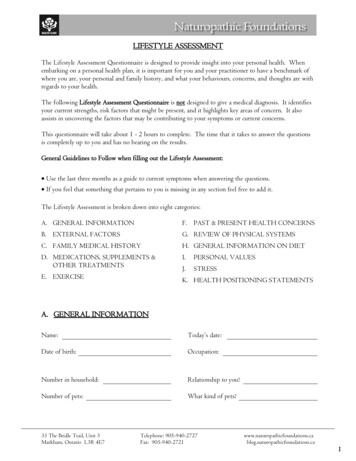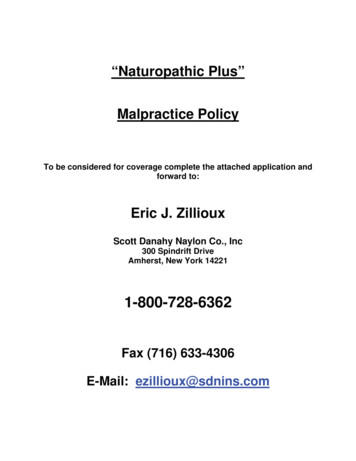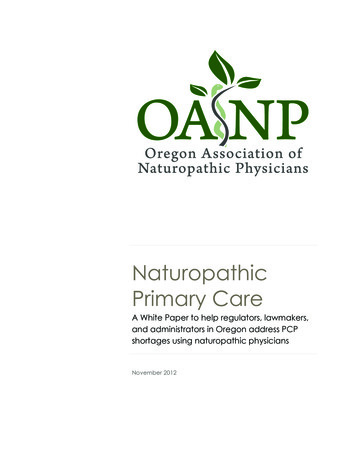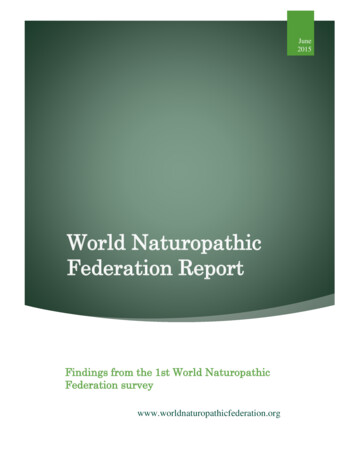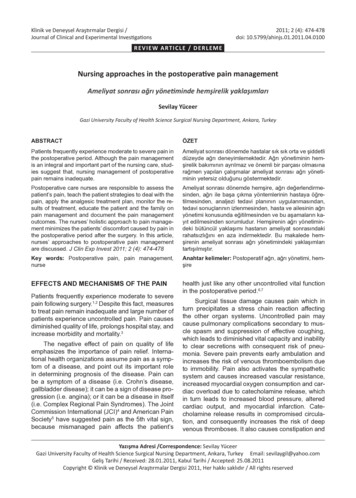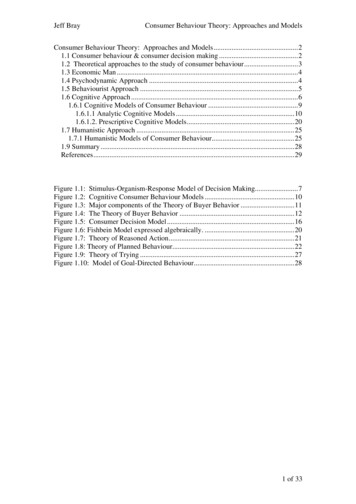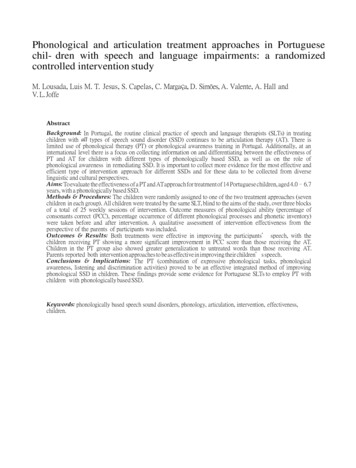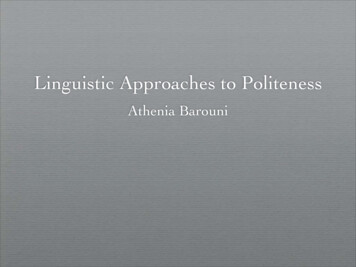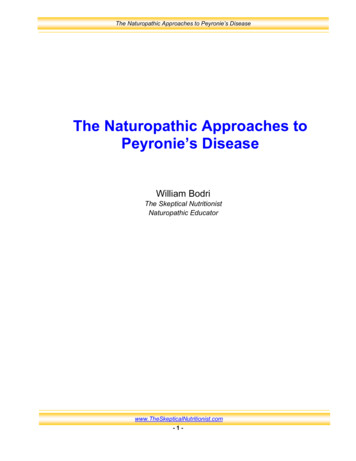
Transcription
The Naturopathic Approaches to Peyronie’s DiseaseThe Naturopathic Approaches toPeyronie’s DiseaseWilliam BodriThe Skeptical NutritionistNaturopathic Educatorwww.TheSkepticalNutritionist.com-1-
The Naturopathic Approaches to Peyronie’s DiseaseCopyrightCopyright 2004, William BodriAll rights reserved in all mediaFirst edition 2004.Top Shape Publishing, LLC1135 Terminal Way Suite 209Reno, Nevada 89502No part of this book may be reproduced, stored in a retrieval system, or transmittedby any means, including but not limited to electronic, mechanical, digital copying,printing, photocopying, recording, or otherwise without written permission from kepticalNutritionist.com-2-
The Naturopathic Approaches to Peyronie’s DiseaseHealth DisclaimerThis information should not be construed as medical advice or instruction, and is notintended to replace the attention or advice of a physician or other health careprofessional.No actions should be taken based solely on the contents of this book. Theinformation within is for education purposes only, and should not be interpreted as arecommendation for a specific treatment plan, nor should this information be used inplace of the medical opinion of a qualified health care professional.Anyone who wishes to embark on any dietary, drug, exercise, or other lifestylechange intended to treat or prevent a specific condition should first consult with andseek clearance from their doctor; readers who fail to consult appropriate healthauthorities assume the risk of any injuries.The author and publisher are not responsible for any errors or omissions in thisbook. Please call a health professional immediately if you think you may be ill.www.TheSkepticalNutritionist.com-3-
The Naturopathic Approaches to Peyronie’s DiseaseTable of ContentsIntroduction . 5Vitamin E and Vitamin C in Tandem . 9Nattokinase and Lumbrokinase: The Natural Clot and Fibrin Busting Enzymes . 26Serrapeptase, “The Second Gift From Silkworms”. 38The ION Blood Panel . 56Para-aminobenzoate, or PABA . 89Thacker’s Formula . 93Alter Your Diet By Avoiding Your Food Sensitivities . 102Colloidal Copper Spray for Scar Tissue . 117Oral and Intravenous Chelation for Calcified Plaques. 122Summary . 139www.TheSkepticalNutritionist.com-4-
The Naturopathic Approaches to Peyronie’s DiseaseIntroductionPeyronie’s disease, which was first described in 1743 by the French surgeon,Francois de la Peyroine, is a condition where a plaque or hard lump forms on theerection part of the penis, and which can develop into hardened fibrotic tissue orscar.Cases can range from mild to severe and while the plaque itself is benign, ornoncancerous, the fibrotic, palpable plaques that eventually harden cause curvatureor bending of the penis and diminished rigidity.When a man becomes excited and the penis fills with blood, his penis typicallyelongates and becomes rigid. If a fibrotic region or scar forms in the lining of thepenile tissue, the scar cannot expand as much as the surrounding tissue. It forms arestriction that prevents the penis from expanding in that area, and this results in acurvature at the point of the restriction.In other words, when the penis becomes erect, the scar tissue pulls the affectedarea off at an angle causing a curved penis.The most common areas for the Peyronie’s plaques are (1) on the top of the shaft,which causes the shaft to bend upward, (2) on the underside, which causes thepenis to bend downward, and on (3) both the top and bottom of the penis, whichtends to shorten the penis.In addition to the deformities, the plaques can cause painful erections, difficulties inmaintaining an erection or in achieving an erection. The pain, bending, andemotional distress can interfere with sexual intercourse. Usually the pain decreasesover time but the bend in the penis can make sexual intercourse difficult oruncomfortable, and the loss of the ability to have an erection can prevent intercoursealtogether. The real goal of therapy is to keep or restore sexual function.Peyronie’s disease affects about 1 percent of men (estimates are between .39 and3.5%), but the figure is probably underreported because of the embarrassment mostmen feel about this condition. It occurs most often in men between the ages of 45and 65 (75% of cases fall within this range), with the average age of onset being 53years. It can also affect both younger and older men.www.TheSkepticalNutritionist.com-5-
The Naturopathic Approaches to Peyronie’s DiseaseNo one knows for sure what causes the disease though it often follows a trauma(injury) that causes bleeding inside the penis. Many patients can recall an invasiveprocedure, blunt trauma to the penis or an injury during intercourse at the site of thesubsequent plaque formation. A medical procedure, such as catherization orcystoscopy (the surgeon looks into the bladder following a prostatectomy) can alsocause such injuries.This trauma explanation does not explain why some cases of Peyronie’s diseaseheal within a year or so, while others cases continue to develop slowly. When thecondition persists for years, the plaque often becomes a tough, fibrous tissue andcalcium deposits may form.Another theory is that it is due to an autoimmune disorder, wherein the man’simmune system does not respond properly, which causes the plaque to form in thepenis. Yet another theory is that it is a collagen abnormality, with collagen being thesubstance that builds and remodels connective tissue.Some drugs can cause Peyronie’s disease as a side effect, namely blood pressureand beta blocker heart medications, glaucoma drugs, and pharmaceuticals used totreat multiple sclerosis and seizures.In general, the disease starts as a small bump on the penis shaft below the skin,which can eventually grow into a flat deposit as large as a silver dollar in diameter.This “plaque” invades and replaces the elastic covering of the penis with inflexiblematerial.About 30% of the men who experience Peyronie’s experience hardened tissue andloss of elasticity in other body areas, such as the hands or feet. One such conditionis Dupuytren’s contracture, which entails a cord-like thickening across the palm thatcauses the fingers to pull inward, and Ledderhose’s disease. There is a 10-40%chance that the descendant of a Dupuytren’s contracture sufferer will develop thatproblem, and a 15% (16-20%) chance that a man so afflicted will develop Peyronie’sdisease.In about half of the cases, Peyronie’s disease does not worsen. In most cases thecurvature of the penis remains static as the scar matures though for some men, itbecomes worse as fibrosis sets in and the scar contracts and hardens. In about 25%of cases the scarring leads to calcification of the area and when the fibrosisbecomes calcified, the angulation becomes quite stablewww.TheSkepticalNutritionist.com-6-
The Naturopathic Approaches to Peyronie’s DiseaseThe disease often regresses in men who are less than 50 years old, and who havediscrete plaques that are less than 2 cm long that are soft and without extensivecalcification. About 20-50% of men who have Peyronie’s disease experiencespontaneous remission. A review of Peyronie’s patients in 1990 by Gelbard et alfound that 40% felt that the disease worsened over time, while 13% felt it improvedand 47% noted no change (stable symptoms).The disease process takes about 12 months to stabilize and during this time maydisappear without treatment. For all intents and purposes, we can say the conditionthen has an acute and chronic, stable or mature phase.The acute phase lasts for the first 18-24 months, wherein there is a changinginflammatory pattern involving pain, penile curvature and changing nodules. Thechronic phase can be marked by stable plaque, calcification, and penile angulation.The loss of an ability to have erections is often associated with the chronic phase.Whether or not the onset of deformity associated with the active phase is sudden orgradual, the pain involved with the disease usually resolves and the process seemsto stabilize after 12 to 18 months. A relatively quiescent second maturing phasefollows characterized by progressive deformity and a mature scar. While painfulerections usually resolve in time, penile deformity does not.Because the plaque of Peyronie's disease often disappears without treatment,medical experts sometimes recommend a wait-and-see approach, suggestingwaiting 1 to 2 years or longer before attempting to correct it surgically. During thatwait, patients usually pursue nonsurgical and noninvasive options, some of whichinvolve treatments that have unproven effectiveness. During this time, I particularlyrecommend nutritional and dietary modifications to maximize the chances ofPeyronie’s disappearance.Ordinary medicine finds the condition particularly difficult to treat, and often resortsto surgery if the condition progresses. The purpose of this book is to review theliterature on naturopathic approaches to Peyronie’s disease, as well as nutritionalfindings.In particular, we will discuss:www.TheSkepticalNutritionist.com-7-
The Naturopathic Approaches to Peyronie’s Disease A particular form of vitamin E that should be taken for the disease, and in aparticular wayTwo fibrin-busting substances -- nattokinase and lumbrokinase -- that areknown to increase blood flow to the penis, improving erections, and eat awayat fibrotic tissueA yet more powerful anti-fibrotic enzyme -- serrapeptase -- in an enzymecocktail that may prove useful in helping eliminate Peyronie’s plaques, eatingaway at excess fibrin and cleaning the blood of floating immune complexesBloodwork tests you can order to determine your own personal nutritional andbiochemical status, and from the findings thus proceed with guidance fornaturopathic, biochemical modulation of the diseaseA B-vitamin protocol that has proved useful in some cases of Peyronie’sDietary advice on the specific foods to eliminate from your diet in order tominimize inflammatory responses, and permit your body’s full energies to bedevoted to internal healing rather than fighting off other subclinical allergicreactionsA castor oil based formula you can rub on the penis that has proven helpful inbreaking up Peyronie’s plaquesA metal spray that softens scar tissueAn intravenous or oral procedure, using EDTA, physicians sometimes use tohelp remove tissue calcificationAll together you’ll have nine different approaches for Peyronie’s disease (thoughactually more are discussed) that can be used together to help maximize yourchances for eliminating the condition.www.TheSkepticalNutritionist.com-8-
The Naturopathic Approaches to Peyronie’s DiseaseVitamin E and Vitamin C in TandemLet’s say you just discovered you have Peyronie’s disease, and it’s in the earlystages. Many cases of Peyronie’s are self-limited and actually resolve themselvesand go away by themselves, and the disease usually takes about 12 months tostabilize.Why, how who knows?If your Peyronie’s is due to some biochemical abnormality in the body that could bemodulated through nutritional vitamin and mineral supplementation -- just as highcholesterol is now being modulated with folic acid, vitamins B12- and B6 due to thebiochemical tie-in with “homocysteine” -- you’d want that biochemical abnormalityfound and corrected.I’ll tell you how to find out if there is any APPARENT abnormality in your blood workthat your doctor might miss, but not in this chapter.If the condition that’s starting is due to some diet tie-in -- because of what you eat -I’ll tell you how to find that out, too.People always think that if they have an underlying genetic condition that a particulardisease outcome is fated, but actually your genes are “triggered” or “express”themselves based on what you wash over them, namely what you eat. In otherwords, change your diet and you can correct or prevent the expression of certaingenes. For example, if you have poor genes for heart health and watch your diet,heart problems may never materialize.Now pharmaceutical companies don’t want people to become too knowledgeableabout this -- about the fact that what you “wash over your genes” due to your diet(the foods you eat) can control gene expression, but that’s the truth of the matterand what control of medical conditions through diet and supplements is all about.When you take vitamin E or C or B or whatever, you are actually flooding your bloodstream with these nutrients that will activate certain biochemical reactions which arecontrolled by genes. In other words, you modulate or control gene expression bywhat you eat. The cellular receptor sites on the surface of cells are actually activatedwww.TheSkepticalNutritionist.com-9-
The Naturopathic Approaches to Peyronie’s Diseaseby these substances, and they, in turn, are what trigger gene expression andbiochemical reactions. So what you eat becomes your destiny.The same logic of a diet tie-in may hold for Peyronie’s disease, but no one knows. Idon’t know either and cannot say one is there. However, I can talk about what YOU,because of your own biochemical individuality, specifically should not eat because itmay be contributing to ill health in general, and perhaps this condition.Somehow, in some way what you eat may tie-in to the expression of Peyronie’s andlater we’ll talk about how to identify those SPECIFIC foods that are bad for youbased on your own biochemical individuality. I’ve seen cases whether changing thediet reverses arthritis, allergies, headaches, MS, cancer, and I’ve even been toldof cases where diet changes stopped epileptic seizures.Changing your diet can affect what happens to your penis!So while no one has done research on this yet, I’m going to tell you how you can findout any foods bad for you FOR CERTAIN. Whether it contributes to Peyronie’s ornot, at least you’ll have the information and staying away from those foods will dowonders for your health anyway.If your Peyronie’s is due to a circulatory mishap that will eventually resolve itself, asin many cases it does, you’d want to know how to maximize your chances of helpingthe condition go away naturally.That’s where vitamin E comes in and your initial doctor’s visit.In most cases, if you are just seeing your doctor for the first time with a mild case ofPeyronie’s that’s just started, he or she is going to tell you, “Take 400 IU of vitaminE three times a day, and let’s see what happens.”The vitamin E is cheap, it won’t hurt you, it may help your heart and has all sorts ofother positive circulatory system effects. It helps dissolve circulatory blockages.Quite a few studies suggest that taking vitamin E above the RDA will providebeneficial effects in preventing a number of degenerative conditions, especiallythose related to vascular and circulatory problems.Peyronie’s disease, to some extent, falls into this category.www.TheSkepticalNutritionist.com- 10 -
The Naturopathic Approaches to Peyronie’s DiseaseMany men have reported that this vitamin E advice alone has helped them and usingit, their Peyronie’s disease resolved itself over time when they were using 1000-1500IU of vitamin E, in divided doses throughout the day. However, no one yet hasactually proved that these reversals were due to the vitamin E. Also, no one hastested whether taking the vitamin E in one mega-dose is a better protocol.The initial use of vitamin E for Peyronie’s was reported by Scott and Scardino in1948, who treated 23 patients with 200-300 mg per day (“A new concept in thetreatment of Peyronie’s disease,” South Med J, 41:173, 1948). Early studies on itsuse in Peyronie’s found that 91% of patients reported a decrease in plaque size and78% experienced a decrease in penile curvature.A 1990 review by Gelbard et al found no significance difference between Peyronie’sgroups treated and not treated with vitamin E as regards their perceptions of pain,bend, the ability for intercourse, and over-all perception of the disease progression.Pryor and Farrel reported that 25% of patients taking vitamin E noted animprovement in pain, but minimal effects on plaque size or penile curvature.In a 1987 study, Devine et al reported a resolution of plaques (20%) and curvature(33%) with vitamin E therapy. However, in 1993 with a follow-up study, Devine andSnow reported at a National Institutes of Health conference on Peyronie’s diseasethat a small scale study of 105 patients treated with oral vitamin E had the followingresponse: there was a 99% reduction in pain, a 13% reduction in penile curvature,but 70% of patients were found to have no objective improvement in their symptoms.Here is a summary of the results of these vitamin E 840107Improvementin Pain100%82%35%99%Plaque 8%Not reported10%33%The Devine and Snow reported improvements give hope for Peyronie’s diseasesufferers but larger controlled studies have not been completed to substantiate theeffectiveness of this treatment.www.TheSkepticalNutritionist.com- 11 -
The Naturopathic Approaches to Peyronie’s DiseaseNevertheless, because it’s so cheap, so easy, the side effects are virtuallynonexistent, it’s the first thing you should try. Taking vitamin E doesn’t rule outtrying other things at the same time, and this is the first, easiest, simplest thing to try.But keep reading, because there is a special type of vitamin E I suggest you use.Before we go further, there are some other tie-ins you should know about thatprovide some logic to the vitamin E therapy.In treating fibrocystic breast disease -- which involves cysts, tissue thickening andfibrosis (scar like connective tissue) -- Dr. Jonathan Wright, MD, has long usedvitamin E (along with selenium and either evening primrose or black currant oil, inaddition to iodine and magnesium) supplementation.I’m not saying there is a tie-in between fibrocysts and Peyronie’s but pointing out theuse of vitamin E once again on a fibrocystic, hardening disease.That’s the point.There is also a condition called Raynaud’s syndrome -- where the small arteries,especially in fingers and toes, spasm with possible blood vessel scarring -- that mayhold analogous lessons for Peyronie’s treatment. Vitamin E has been found to havea direct therapeutic effect in Raynaud’s disease (Matoba 1977). In this study,however, vitamin E was combined with vitamin C.That’s the other big part of this first naturopathic home remedy for Peyronie’sdisease, which is the fact that vitamin E should probably be taken with vitamin C.Your doctor is unlikely to tell you this, but there are good reasons for the suggestion.First is the fact that vitamin C helps regenerate the effectiveness of vitamin E in thebody, which is just a basic biochemistry fact. The two vitamins recycle each other,which is one reason for the combo suggestion. It means that the vitamin E may stayactive longer.Vitamin E and vitamin C together also help prevent LDL cholesterol from oxidation,and that helps prevent plaque buildup in arteries. But the big information on vitaminC is the following.www.TheSkepticalNutritionist.com- 12 -
The Naturopathic Approaches to Peyronie’s DiseaseIn 1989, Linus Pauling, the eminent American scientist and two-time Nobel Prizewinner, announced that the deposits of plaque seen in atherosclerosis were not thecause of heart disease, but were actually the result of our bodies trying to repair thedamage caused by a long term vitamin C deficiency.Basing his theory on a number of important scientific findings, Pauling believed thatplaque is the body’s attempt to reinforce and patch weakened blood vessels andarteries that would otherwise rupture. So in terms of Peyronie’s disease, the ideathat plaque may form due to a trauma to the penis may have merit according to thistheory.One finding that contributed to Pauling’s theory was the discovery that the plaquedeposits found in arteries are made up of a special form of cholesterol calledlipoprotein (a) or Lp(a). Lp(a) is a special form of LDL cholesterol -- not ordinary LDLcholesterol -- that forms the thick sheets of plaque that obstruct arteries. In a laterchapter we’ll discuss Lp(a) and how you can measure it in your own blood to see ifany of this discussion has relevance.Another finding central to Pauling’s theory was the observation that plaque depositsare not formed randomly throughout the circulatory system. For instance, in 1985, ateam of researchers verified that plaque only forms in areas of the artery thatbecome damaged. It appears in areas of high mechanical stress -- in our case,perhaps the penis.Now we all know that cracks can form in a garden hose that has become weak andworn from constant bending and high-pressure. Bend a metal paper clip severaltimes and it soon breaks at the weakest juncture. Similarly, cracks and tears oftenform in the lining of our arterial walls, especially from trauma. As these tiny cracksopen up they expose strands of the amino acid lysine (one of the primarycomponents of collagen) to the blood stream.The lysine in these strands then attracts the Lp(a) cholesterol, which is especially'sticky' and attracted to lysine. Drawn to the break, Lp(a) begins to collect at the spotand attach itself to the exposed strands. As lipoprotein(a) covers the lysine strands,more free lysine floating in the blood is drawn to the growing deposit and the plaquedeposit grows and grows.Over time, this process continues to escalate as lysine and Lp(a) are both drawnfrom the blood to build ever-larger deposits of plaque. As the plaque grows, thiswww.TheSkepticalNutritionist.com- 13 -
The Naturopathic Approaches to Peyronie’s Diseaseprocess gradually reduces the inner diameter of the blood vessels and restricts itscapacity to carry the blood.In considering this newly described process of plaque formation in atherosclerosis,Pauling recognized that there was a great similarity to the underlying processesseen in scurvy, which is a deficiency of vitamin C. First of all, all animals that caninternally manufacture their own vitamin C (humans, apes and guinea pigs are theonly ones who cannot) do not experience cardiovascular disease. Secondly, the onlyanimals that do produce Lp(a) are those which, like man, have also lost the ability toproduce their own vitamin C -- namely apes and guinea pigs once again.Pulling all this information together, Pauling reasoned that the ability to form plaqueis really our body’s own attempt to repair damage caused by a long-term deficiencyof vitamin C, so in Peyronie’s disease I would increase the vitamin Csupplementation.When our arteries became weak and began to rupture, the body responds by 'gluing'the damaged areas together with Lp(a) to prevent us from experiencing a slow deathdue to internal bleeding. In essence, plaque is the body’s attempt to patch bloodvessels damaged by low-level vitamin C deficiency. Accordingly, Linus Paulingbelieved that conventional 'triggers' of plaque formation, such as homocysteine andoxidized cholesterol, are actually just additional symptoms of vitamin C deficiency.Do you see the relevance for vitamin C supplementation with Peyronie’s?Peyronie’s disease actually has a collagen component to it, which we’ll discuss later,and research conducted with animals that cannot make their own vitamin C foundthat when vitamin C levels are reduced, collagen production drops. Blood vesselwalls also then have a tendency to become thinner and weaker, so the collagenproduction is abnormal.When these animals are deprived of vitamin C, other studies show that theyincrease blood levels of Lp(a) and form plaque deposits to strengthen arteries andprevent vessel ruptures. In short, more vitamin C means more collagen and lessplaque, and the arteries are kept open.Taking all this into account, Linus Pauling therefore recommended people takevitamin C to prevent atherosclerosis, along with the amino acids lysine and proline tohelp remove existing plaque and strengthen weak and damaged arteries. In tellingwww.TheSkepticalNutritionist.com- 14 -
The Naturopathic Approaches to Peyronie’s Diseasepeople to take lysine and proline, he hoped it would act to release lp(a) from plaqueformation and prevent the further deposition of it.Our bodies produce collagen from lysine and proline. Pauling reasoned that byincreasing concentrations of lysine and proline in the blood, Lp(a) molecules wouldbind with the free lysine, rather than with the lysine strands exposed by the cracks inblood vessels. He was basically giving the Lipoprotein(a) a different target to attackthan the lysine sticking out of arterial walls.The Linus Pauling recommendations for the reversal of atherosclerotic plaqueinvolve tremendously high amounts of vitamin C, proline and lysine, and vitamin E.He recommended five to ten grams (5,000-10,000 mg) of vitamin C daily, 3 grams oflysine and proline twice a day, and 800-2,400 IU of vitamin E.While I am not recommending this protocol or these amounts, I wanted you to knowabout this underlying mechanism and call attention to the recommendation of takingvitamin C along with E, as well as raise a flag about lp(a), lysine and proline. Whenlater we talk about ION panel results, we will encounter these blood factors onceagain and will then find out whether we should consider lysine and prolinesupplementation.Now the other big reason you should probably be taking vitamin E and vitamin Ctogether is because of a famous landmark study published by JAMA - the Journal ofthe American Medical Association -- in 1997.When this study was published it really made the news because JAMA is themouthpiece of the AMA which tends to despise the use of natural supplements foranything. Pharmaceuticals are almost always its recommended solution to anythingso when the AMA admits that vitamins or supplements do anything, you have to payattention.What they did in this study was take 20 people and randomly divide them into threegroups. One group was given a high fat content breakfast to eat. A second groupwas given a low fat content breakfast. A third group was fed a high fat contentbreakfast, but were pre-treated with 1000 mg of vitamin C and 800 units of vitaminE.At the end of the meal, the blood flow through the brachial artery in the arm of eachparticipant was measured.www.TheSkepticalNutritionist.com- 15 -
The Naturopathic Approaches to Peyronie’s DiseaseNow, Peyronie’s is not a disease that is directly related to cholesterol, but it is relatedto vascular issues, fibrotic tissue, blood flow, inflammation and plaque so I want youto think of the analogous logic here. Nothing can be said definitively becausepractically nothing has been studied with Peyronie’s, but there are already goodreasons for taking vitamin C and E together and you should consider this study aswell.Think about your problem and ponder its implications.After eating the high fat meal, the first group experienced a reduction in blood flow inthe arm of 28% and significant restriction of blood flow for the next 4 hours. The lowfat meal group experienced no change in blood flow whatsoever, but those who atethe high fat meal AND took the vitamin E and C supplements did not experience anyreduction of blood flow in the arm either.Get it?Maybe taking vitamin E will not help clear up the condition, but if there somerelationship to plaque deposition as the Peyronie’s plaque starts to get larger, thisstudy also suggests that it’s probably wise to be taking the vitamin E with vitamin Ctogether.This combo is certainly not going to hurt you, as millions of people take the twovitamins together every day. I’m just worried you might be someone who doesn’ttake multivitamins at all and who will simply go out, buy a cheapo brand of vitamin E,and then suffer because they didn’t do everything possible to reverse the conditionor prevent it from getting worse by taking C along with it.This study is just another reason why you should consider taking both vitamin E andC together. As to lysine and proline, we’ll have to wait for another chapter to find out.However, there’s yet another thing you should know about vitamin E and C that yourdoctor is not likely to tell you, which is why you’re buying this book.You’re not going to find this tip in some website article or discussion board becausethose folks are not nutritionally trained and do not know how everything linkstogether. You see, the power of nutritional and naturopathic remedies is in thewww.TheSkepticalNutritionist.com- 16 -
The Naturopathic Approaches to Peyronie’s Diseasedetails and if you don’t know the following facts, you may be putting yourself at riskfor the progression of Peyronie’s disease when vitamin E could actually help you.Here’s the tip.You should buy natural vitamin E, not synthetic vitamin E and only onespecific brand of vitamin E.GNC and other companies manufacture those cheap brands of vitamin E by goingout to the lowest bidder to fulfill their supplement requirements, and instruct them tofill their capsules at the lowest possible cost, which means they contain the lowestquality ingredients.That means little or no biological activity at
If a fibrotic region or scar forms in the lining of the penile tissue, the scar cannot expand as much as the surrounding tissue. It forms a restriction that prevents the penis from expanding in that area, and this results in a curvature at the point of the restriction. In other words, when the penis becomes e
